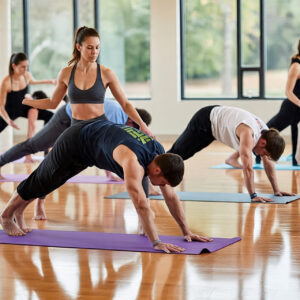
How Yoga Enhances Athletic Performance

In today’s competitive sports world, athletes are constantly searching for ways to gain an edge. Yoga for athletic performance has emerged as one of the most effective tools to boost physical and mental capabilities. From increasing flexibility to improving focus, yoga offers benefits that traditional training alone can’t provide.
In this detailed guide, we’ll explore the surprising connection between yoga and athletic performance, the specific advantages for athletes, and practical ways to incorporate yoga into your fitness routine.
Why Should Athletes Practice Yoga?
It’s no secret that elite athletes — from runners to footballers to swimmers — are turning to yoga to enhance their performance naturally. Unlike repetitive gym workouts, yoga addresses the body and mind together, offering holistic benefits that complement any sport.
Top reasons athletes are embracing yoga:
-
Greater flexibility and mobility
-
Enhanced strength and balance
-
Stronger core and stability
-
Better breath control for endurance
-
Faster recovery and injury prevention
-
Improved mental focus and resilience
In short, yoga helps athletes move better, think sharper, and recover faster.
The Physical Benefits of Yoga for Sports Performance
Let’s break down exactly how yoga supports physical conditioning for athletes.
1️⃣ Flexibility and Range of Motion
Many sports create tightness in specific muscles due to repetitive movements. Over time, this can limit motion and increase injury risk. Yoga poses such as Downward Dog, Pigeon Pose, and Lizard Lunge help loosen these tight areas, increasing flexibility and joint range of motion.
💡 Transitionally, with better flexibility, athletes experience smoother movements and fewer muscle strains.
2️⃣ Balance and Coordination
Sports like basketball, tennis, and soccer demand quick direction changes and stable footing. Yoga poses like Tree Pose, Warrior III, and Half Moon challenge and improve balance, helping athletes stay grounded during high-intensity play.
✅ Result: Improved control, agility, and injury prevention.
3️⃣ Core Strength and Stability
A strong core is essential for almost every athletic movement. Yoga doesn’t just work the outer abs — it targets deep stabilizing muscles. Poses like Boat Pose, Plank, and Side Plank build lasting strength that enhances posture, power, and endurance.
Consequently, athletes can generate more power while minimizing strain on the spine.
4️⃣ Breath Control and Endurance
One of yoga’s most unique contributions is its focus on pranayama (breath control). Techniques like Ujjayi breathing or alternate nostril breathing train athletes to use their lungs more efficiently.
This leads to greater stamina and improved oxygen delivery during performance.
5️⃣ Recovery and Injury Prevention
Athletes often deal with sore muscles and fatigue after training or competition. Gentle yoga flows and restorative postures help promote blood circulation, reduce inflammation, and accelerate recovery.
✨ In addition, yoga identifies and corrects muscular imbalances, reducing the chance of injuries like strains or joint issues.
The Mental Benefits of Yoga for Athletes
Athletic excellence is as much about the mind as it is about the body. Yoga sharpens mental resilience, giving athletes an advantage in both practice and competition.
Focus and Concentration
Through mindful breathing and meditation, yoga teaches athletes to stay present and composed under pressure. Visualization, body scans, and meditation are proven techniques that improve focus during critical moments.
Stress Management and Emotional Strength
Performance anxiety, high expectations, and intense competition can take a toll. Yoga provides a powerful toolkit for managing stress and promoting emotional well-being.
The result? A calm, focused, and confident mindset, ready to handle challenges and bounce back from setbacks.
Best Types of Yoga for Athletic Performance
Wondering which yoga style is best for your sport? Let’s look at some top choices:
✅ Vinyasa Flow: Builds flexibility, strength, and stamina with dynamic movement.
✅ Yin Yoga: Deeply stretches connective tissue for better joint health and long-term mobility.
✅ Restorative Yoga: Ideal for recovery days; helps relax and heal the body.
✅ Power Yoga: Strengthens muscles and challenges endurance — perfect for athletes who like intensity.
By blending these styles, athletes create a well-rounded practice that supports all areas of performance.
How to Add Yoga to Your Training
Adding yoga doesn’t mean changing your entire routine. Even small, consistent efforts pay off over time.
Start small: Try 10-20 minutes of yoga 2-3 times a week.
Focus on your sport’s needs: Runners may emphasize hip and hamstring stretches, while swimmers might work on shoulder mobility.
Use yoga for active recovery: Gentle sessions after workouts help your body recover without overloading it.
Make it a habit: Consistency is key — you’ll notice results when yoga becomes part of your regular training.
Sample Yoga Routine for Athletes
If you’re ready to try yoga for athletic performance, here’s a simple sequence:
1️⃣ Low Lunge (Anjaneyasana) – Opens tight hips and strengthens legs.
2️⃣ Triangle Pose (Trikonasana) – Stretches hamstrings, hips, and spine.
3️⃣ Plank Pose – Builds core and upper body strength.
4️⃣ Pigeon Pose – Releases deep hip tension.
5️⃣ Supine Twist – Aids spinal flexibility and relaxation.
6️⃣ Child’s Pose – Encourages recovery and mindful breathing.
Hold each pose for 30-60 seconds, focusing on your breath.
Final Thoughts
Incorporating yoga into athletic training is no longer optional for athletes aiming for peak performance — it’s essential. By enhancing flexibility, strength, focus, and recovery, yoga helps athletes gain a natural competitive edge.
No matter your sport or fitness level, start small, stay consistent, and watch as yoga transforms your athletic journey.